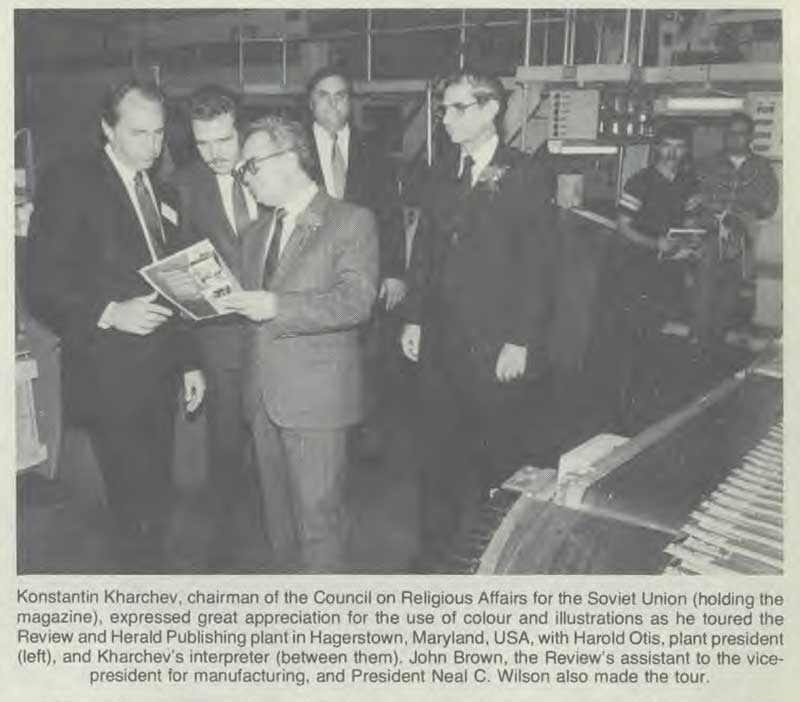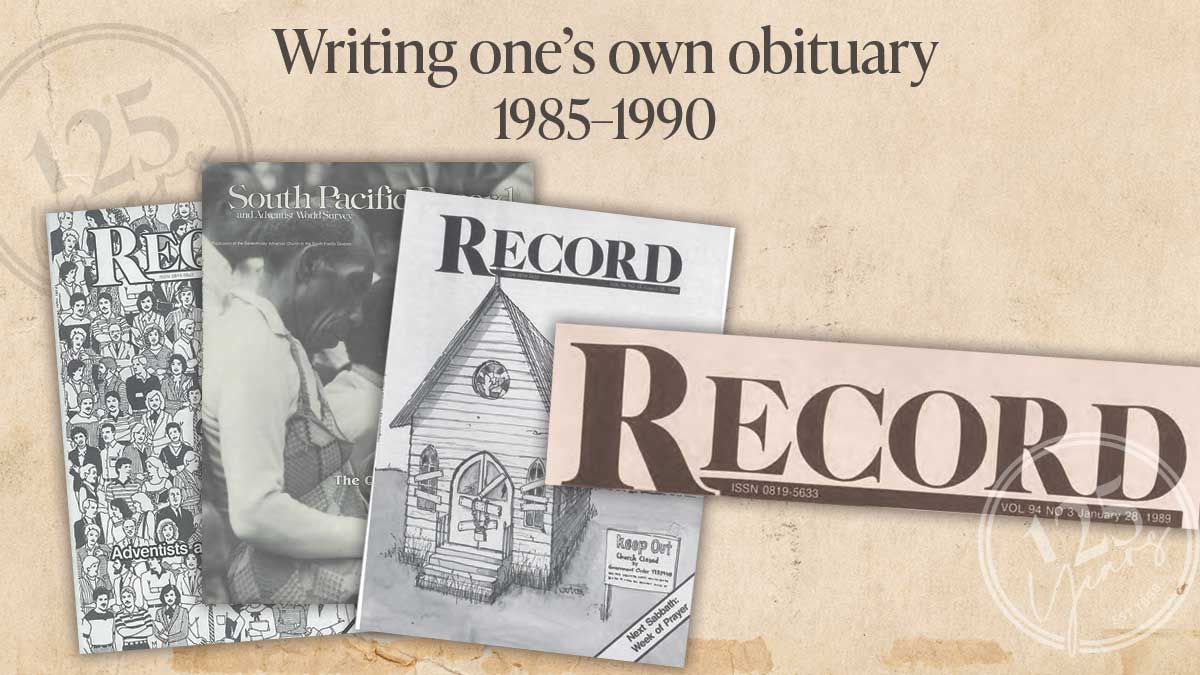Another period of progression for the magazine—during this time, the name changed from the rather wordy Australasian Record and Advent World Survey to the no less wordy South Pacific Record and Adventist World Survey when it was voted in 1985 to rename the region the South Pacific Division. By 1987, the publication had shifted again to be known simply as RECORD, a much simpler designation.
In the last issue we detailed the coverage of the Chamberlain case and in this time period (March 1, 1986), we find this note in Flashpoint: “WE WISH we could tie a yellow ribbon round each copy of the RECORD today to show exactly how we all feel at the return to her family of our dear sister Lindy Chamberlain. What a Sabbath of rejoicing we experienced! We praise God for this answer to our prayers and await His further leading. Our love and best wishes are expressed to the whole Chamberlain family as they re-establish their family unit. Our editorial next week will express our sentiments more fully.”
The editorial the next issue (March 8), written by editor Geoffrey Garne, is entitled “A Sabbath of rejoicing” and links the suddenness and excitement of Lindy’s release with the suddenness of Jesus’ return.
Another significant event in 1986 was the opening and dedication of Avondale College (now University) church on March 8. Designed by Adventist architect, Dr Bruce Judd, the announcement was made in the issue of the same date.
A number of initiatives and campaigns are run as full page ads and inserts during this period. Quit smoking programs, the 1000 days of reaping campaign, calls to donate a church to PNG where growth is rapid and church frames are needed—the list goes on. The Mission 90 logo is a regular feature.
The look, tone and feel of Record starts to change more quickly during this period. There are more full-page pictures on the front cover and images inside get bigger and more frequent. There are illustrations on the cover and it is during this period that Berto’s “Just a coincidence” comic appears—a cartoon that was printed on and off until around 2017.
A number of the changes witnessed in this period can be put down to editorial style, as an American with Australian connections, James Coffin, took over from South African Geoffrey Garne. Garne’s last editorial appeared in the August 30, 1986 issue. Garne’s editorial style was often focused on news and world events. For example, he would focus on event’s such as the Pope’s visit to Australia, highlighting his background in Signs of the Times (he was the South African editor of that publication before he came to Australia). He seemed to take himself and his role quite seriously, while perhaps never quite feeling comfortable (B Manners, “Adventist Record”, Encyclopedia of Seventh-day Adventists). When Garne finished he was 60 years old. Coffin was 35, a pastor who had worked as news editor at Adventist Review and that background in news he used to bring a more editorial flavour to the magazine.
His editorials had a lighter tone, sometimes with a cynical, self-deprecating edge like “To beard or not to beard” (and the follow up issue) about Adventists being unwelcoming. His first editorial, “Writing one’s own obituary” (October 4, 1986) demonstrated this lighter, more modern writing style (his name was Coffin after all).
Here is an excerpt from the Encyclopedia of Seventh-day Adventists about the transition.
“The South Pacific Division president, Walter Scragg, an experienced communicator within the church, and other senior church officials wanted the Record to move on from the theological issues that had impacted the church. Coffin was chosen as a ‘younger mind’ (in his mid-30s at the time of his appointment) and instructed to make the Record contemporary, to enliven it in a ‘deliberate attempt to move down a generation’. Significantly, he was given freedom to publish letters that attacked the church’s decisions.
Scragg said, ‘We tried to make the Record more representative of the whole church, not just administration. The idea was that we should convey the idea that the Record is owned by the whole church and you have your right to be heard . . . even though it wasn’t something that the editor or the church leadership agreed with.’
Coffin negotiated with Scragg for a journalistically sound magazine that was selective in what was printed, with more time spent on editing and rewriting, if necessary. ‘My goal was to support the 27 fundamentals of the church, but at the same time allow people a significant amount of latitude to express views and opinions and try to use this as a sort of catharsis to help bring healing.’”
The world was heading toward the end of the Cold War and the USSR era. A report from January 17, 1987 describes a visit to the General Conference by a Soviet leader:

“In May last year, just two weeks after the nuclear disaster at Chernobyl, a delegation, led by the General Conference president, visited the USSR and met with several highly placed Soviet officials in Moscow. Late last year, church leaders hosted Konstantin Kharchev, chairman of the Council for Religious Affairs, in a whirlwind tour of the Review and Herald Publishing Association, Shady Grove Adventist Hospital, and Takoma Academy. The four-hour visit concluded with a vegetarian luncheon in the GC dining room.”
At the time, it was estimated there were 32,000 Adventists in the Soviet Union. The Berlin Wall came down in 1989.
While different columns have come and gone since, this was the era when Record became much more like what it is today, in terms of the balance of news and features, the way news is edited and the style of the letters’ page.
Sunday laws:
Leaders of a coup in Fiji introduced a Sunday Observance Decree in 1987, forcing all citizens to worship on Sunday and refrain from all work. Fijian Adventists turned these circumstances to their advantage by visiting, holding meetings and doing missionary work. The church advised members to follow the laws in place but also made submissions to the government on behalf of religious liberty (Record, August 26, 1989). The Sunday Observance Decree stayed in force until October 1995.






